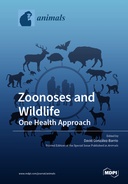Explore

Zoonoses and Wildlife: One Health Approach
0 Ungluers have
Faved this Work
Login to Fave
Throughout history, wildlife has been an important source of infectious diseases transmissible to humans. Today, zoonoses with a wildlife reservoir constitute a major public health problem, affecting all continents. The importance of such zoonoses is increasingly recognized, and the need for more attention in this area is being addressed. The total number of zoonoses is unknown, some 1,415 known human pathogens have been catalogued, and 62% are of zoonotic origin [1]. With time, more and more human pathogens are found to be of animal origin. Moreover, most emerging infectious diseases in humans are zoonoses. Wild animals seem to be involved in the epidemiology of most zoonoses and serve as major reservoirs for transmission of zoonotic agents to domestic animals and humans [2]. The concept of the ‘One Health’ approach involving collaboration between veterinary and medical scientists, policy makers, and public health officials, is necessary to foster joint cooperation and control of emerging zoonotic diseases [3]. Zoonotic diseases caused by a wide range of arthropods, bacteria, helminths, protozoans, and viruses can cause serious and even life-threatening clinical conditions in animals, with a number of them also affecting the human population due to their zoonotic potential. The aim of the current Special Issue is to cover recent and novel research trends in zoonotic diseases in wildlife, including the relevant topics related to wildlife, zoonosis, public health, emerging diseases, infectious diseases and parasitic diseases.
This book is included in DOAB.
Why read this book? Have your say.
You must be logged in to comment.
Rights Information
Are you the author or publisher of this work? If so, you can claim it as yours by registering as an Unglue.it rights holder.Downloads
This work has been downloaded 118 times via unglue.it ebook links.
- 118 - pdf (CC BY) at Unglue.it.
Keywords
- aerosols
- Anaplasma phagocytophilum
- arbovirus
- Atlantic Spain
- badger
- Balantioides coli
- Bats
- Biology, Life Sciences
- Blastocystis
- c-ELISA
- camera-traps
- Cattle
- Coxiella burnetii
- Cryptosporidium
- Cryptosporidium hominis
- Dust
- Enterocytozoon bieneusi
- Epidemiology
- European bison
- faeces
- filter card
- Giardia
- Giardia duodenalis
- Helicobacter spp.
- Humans
- interactions
- Isolation
- Leptospira interrogans
- macaque
- Mathematics & science
- Meles meles
- micromammals
- microscopic agglutination test
- molecular epidemiology
- Mycobacterium tuberculosis complex
- n/a
- Non-human primates
- Non-Tuberculous Mycobacteria
- One Health
- P22 ELISA
- PCR
- phylogenesis
- Preservation
- Q fever
- Rats
- Reference, information & interdisciplinary subjects
- Research & information: general
- RT-PCR
- Ruminants
- Salmonella
- Serology
- seroprevalence
- Slovenia
- Storage
- Sus scrofa
- tick
- Transportation
- Troglodytella
- Tuberculosis
- Turtles
- West Nile virus
- wild ungulates
- wildlife
- wildlife rescue centres
- wildlife-livestock interface
- zoological garden
- Zoology & animal sciences
- zoonosis
- zoonotic
Links
DOI: 10.3390/books978-3-0365-3735-1Editions

